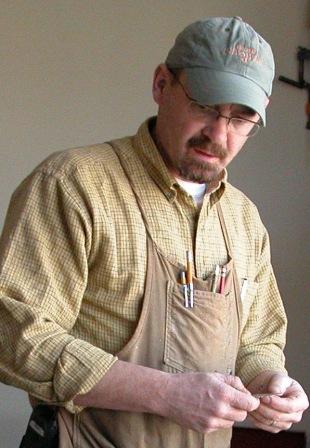While the glue was drying I set about making the jig to create the through mortises. Mortises always have to be exactly the right size, but when there are so many you'd never get the sides tenons in the mortices without extremely accurate cuts. The setup has to be absolutely exact. Here's how it was done.
First, I ripped a piece of 3/4" plywood exactly the width of the tenons. I spent some time getting this just right. Then, I fitted a piece between each tenon like this.
Again, I spent a lot of time getting these tight and well fit. The top and bottom tenons are an exact copy of each other, but there could be very small differences due to the fact that I flipped the board on the tablesaw. So, I decided to make a jig for both the bottom and top mortices. I then left the pieces between the tenons and glued plywood to both sides of the small plywood insets. I was left with the jig below. It is an exact copy of the mortices I need to cut in the top and bottom and this spacing will be exact.
The next day, after the top and bottom panels' glue was set I set about laying out the exact lengths of the top and bottom. I ended up a little longer than my drawing, but very close to what I planned. I liked the radius end just as I had planned it. Above is a trammel used to scribe large radiuses.
I did not cut the radius. Instead, I cut the top square after adding an inch to each end. This way I have a good square end to work with and I don't have to worry about tearing up the end.

Upon making the rough "final" cut and establishing a final size of the desk I was ready for the mortices, which were located 4" from each end.
The jig has to be placed exactly and fixed tightly to the top. The first step is to drill holes through each square. This allows you to get a router bit into the jig and also removes material so the routing isn't a problem. The less material the router has to remove, the better. You just get a smoother cut with less possibility for problems.

Once the holes were drilled and the material removed I moved the jig to the underside of the board. You could use a router with either a top or bottom bearing - I have a bottom bearing and would rout from the top.
For those who are reading this and aren't woodworkers, here is a picture of the router bit that does the work. The idea is that the bearing edge is on the same plane as the cutter. Thus, the router cuts a shape exactly the size and shape of the whatever it bears against. In this case, the jig I built.
This is what the bottom looks like once the holes are finished with the router and pattern bit. As you can see, the holes have radiused corners which I will have to square off by hand.
Also, I need a dado the full length of the board and 1/8" deep and the full width of the board. This is in final product. If this all looks easy, it took about twelve hours total. I guess I have about twenty-five hours into it so far.
I haven't had any disasters yet and things have gone smoothly.
 |
| the dado |
 |
| the side piece fit into the bottom. |
 |
| The other side. The tenons will be cut down, but are left long so the fined edge doesn't get beat up. |






















.JPG)
.JPG)
.JPG)
.JPG)

.JPG)
.JPG)
.JPG)
.JPG)

.JPG)
.JPG)
.JPG)



























